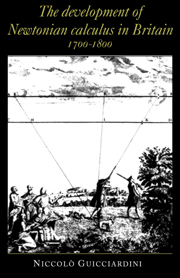Book contents
- Frontmatter
- Contents
- Introduction
- OVERTURE: NEWTON'S PUBLISHED WORK ON THE CALCULUS OF FLUXIONS
- PART I THE EARLY PERIOD
- PART II THE MIDDLE PERIOD
- 4 THE TEXTBOOKS ON FLUXIONS (1736–58)
- 5 SOME APPLICATIONS OF THE CALCULUS (1740–3)
- 6 THE ANALYTIC ART (1755–85)
- PART III THE REFORM
- CONCLUSION
- APPENDIX A TABLES OF CONTENTS OF FLUXIONARY TEXTBOOKS
- APPENDIX B PRICE LIST OF MATHEMATICAL BOOKS PRINTED FOR JOHN NOURSE
- APPENDIX C CHAIRS IN THE UNIVERSITIES
- APPENDIX D MILITARY ACADEMIES
- APPENDIX E SUBJECT INDEX OF PRIMARY LITERATURE
- APPENDIX F MANUSCRIPT SOURCES
- Notes
- Bibliography
- Index
6 - THE ANALYTIC ART (1755–85)
from PART II - THE MIDDLE PERIOD
Published online by Cambridge University Press: 14 September 2009
- Frontmatter
- Contents
- Introduction
- OVERTURE: NEWTON'S PUBLISHED WORK ON THE CALCULUS OF FLUXIONS
- PART I THE EARLY PERIOD
- PART II THE MIDDLE PERIOD
- 4 THE TEXTBOOKS ON FLUXIONS (1736–58)
- 5 SOME APPLICATIONS OF THE CALCULUS (1740–3)
- 6 THE ANALYTIC ART (1755–85)
- PART III THE REFORM
- CONCLUSION
- APPENDIX A TABLES OF CONTENTS OF FLUXIONARY TEXTBOOKS
- APPENDIX B PRICE LIST OF MATHEMATICAL BOOKS PRINTED FOR JOHN NOURSE
- APPENDIX C CHAIRS IN THE UNIVERSITIES
- APPENDIX D MILITARY ACADEMIES
- APPENDIX E SUBJECT INDEX OF PRIMARY LITERATURE
- APPENDIX F MANUSCRIPT SOURCES
- Notes
- Bibliography
- Index
Summary
the picture of the fluxional calculus that one can derive from the textbooks written for teaching purposes is not completely representative of the level and methodology of the research carried out by British mathematicians. It was not the kinematical method of fluxions but rather another tool, labelled vaguely as ‘analytics’, which was adopted by some of the most active fluxionists. Among them the most notable were: Thomas Simpson (1710–61), John Landen (1719–90) and Edward Waring (1736–98). ‘Analytics’ had a different meaning for each of the three: however, a general idea can be inferred from their works.
‘Analytics’ was a calculus not immediately interpretable in terms of geometrical or kinematical concepts. The use of symbolism was free from the constraints of interpretability: imaginary numbers, logarithms of negatives and so on were considered admissible. This freedom was not usual in eighteenth-century Great Britain. The limits imposed by the kinematical conception of mathematical quantities were ignored because it was thought that the progress of the fluxional calculus was directly connected with the development of analytical methods. For instance, a formal use of series was considered fundamental: the analytical fluxionists were hoping to attain results by working algebraically on infinite series.
The research on the continent was thought of very highly by the analytical fluxionists, and a genuine attempt was made to import continental methods. This early attempt of reforming the calculus was largely a failure.
- Type
- Chapter
- Information
- Publisher: Cambridge University PressPrint publication year: 1989



